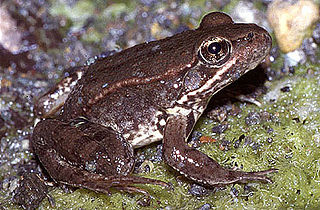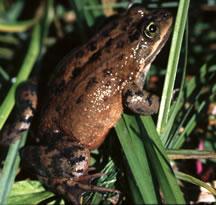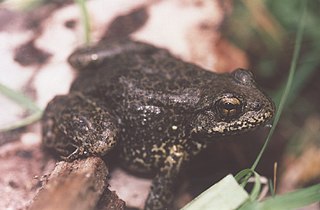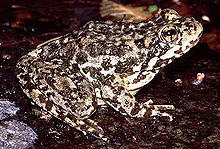
Since the 1980s, decreases in amphibian populations, including population decline and localized mass extinctions, have been observed in locations all over the world. These declines are known as one of the most critical threats to global biodiversity.

Corroboree frogs comprise two species of frog native to the Southern Tablelands of Australia. Both species are small, poisonous ground-dwelling frogs. The two species are the southern corroboree frog and the northern corroboree frog. They are unique among frogs in that they produce their own poison rather than obtain it from their food source as is the case in every other poisonous frog species.

Chytridiomycosis is an infectious disease in amphibians, caused by the chytrid fungi Batrachochytrium dendrobatidis and Batrachochytrium salamandrivorans. Chytridiomycosis has been linked to dramatic population declines or extinctions of amphibian species in western North America, Central America, South America, eastern Australia, east Africa (Tanzania), and Dominica and Montserrat in the Caribbean. Much of the New World is also at risk of the disease arriving within the coming years. The fungus is capable of causing sporadic deaths in some amphibian populations and 100% mortality in others. No effective measure is known for control of the disease in wild populations. Various clinical signs are seen by individuals affected by the disease. A number of options are possible for controlling this disease-causing fungus, though none has proved to be feasible on a large scale. The disease has been proposed as a contributing factor to a global decline in amphibian populations that apparently has affected about 30% of the amphibian species of the world. Some research found evidence insufficient for linking chytrid fungi and chytridiomycosis to global amphibian declines, but more recent research establishes a connection and attributes the spread of the disease to its transmission through international trade routes into native ecosystems.

Rana is a genus of frogs commonly known as the Holarctic true frogs, pond frogs or brown frogs. Members of this genus are found through much of Eurasia and western North America. Many other genera were formerly included here. These true frogs are usually largish species characterized by their slim waists and wrinkled skin; many have thin ridges running along their backs, but they generally lack "warts" as in typical toads. They are excellent jumpers due to their long, slender legs. The typical webbing found on their hind feet allows for easy movement through water. Coloration is mostly greens and browns above, with darker and yellowish spots.

The foothill yellow-legged frog is a small-sized frog from the genus Rana in the family Ranidae. This species was historically found in the Coast Ranges from northern Oregon, through California, and into Baja California, Mexico as well as in the foothills of the Sierra Nevada and southern Cascade Range in California. The foothill yellow-legged frog is a Federal Species of Concern and California State Endangered. A federal rule to list four out of six extant distinct population segments (DPS) under the Endangered Species Act was proposed in December 2021.

The California red-legged frog is a species of frog found in California (USA) and northern Baja California (Mexico). It was formerly considered a subspecies of the northern red-legged frog. The frog is an IUCN near-threatened species as of 2021, has a NatureServe conservation status of Imperiled as of 2015, and is a federally listed threatened species of the United States that is protected by law.

The northern red-legged frog is a species of amphibian whose range is the coastal region stretching from southwest British Columbia to southern Mendocino County in Northern California, and is protected in Oregon and California. As a member of the genus Rana, this species is considered a true frog, with characteristic smooth skin and a narrow waist. This frog requires still waters for breeding, and is rarely found at any great distance from its breeding ponds or marshes.

The Oregon spotted frog is a member of the frog family Ranidae of order Anura. It is a medium-sized aquatic frog endemic to the Pacific Northwest and historically well distributed in the Puget Trough/Willamette Valley province and the Cascade Mountains of south-central Washington and Oregon. It is relatively rare within its range and is listed globally as vulnerable.

The Yosemite toad is a species of true toad in the family Bufonidae. Endemic to the Sierra Nevada of California, the species ranges from the Alpine County to Fresno County. Yosemite toads are only found in the montane to subalpine elevational zone of 1,950–3,445 m (6,398–11,302 ft) asl. The Yosemite toad is similar to the nearby western toad, but in many ways adapted to a high elevation lifestyle. It was initially described during the Grinnell Survey of California, by an undergraduate student of Joseph Grinnell named Charles Camp.

The Mississippi gopher frog, also known commonly as the dark gopher frog, the dusky gopher frog, and the St. Tammany gopher frog, is a critically endangered species of frog in the family Ranidae. The species is endemic to the southern United States. Its natural habitats are temperate coastal forests and intermittent freshwater marshes. This secretive frog is on average 3 in (8 cm) long, with a dark brown or black dorsal surface covered in warts.

Telmatobius culeus, commonly known as the Titicaca water frog, is a medium-large to very large and endangered species of frog in the family Telmatobiidae. It is entirely aquatic and only found in the Lake Titicaca basin, including rivers that flow into it and smaller connected lakes like Arapa, Lagunillas and Saracocha, in the Andean highlands of Bolivia and Peru. In reference to its excessive amounts of skin, it has jokingly been referred to as the Titicaca scrotum (water) frog.

The Carson–Iceberg Wilderness is a federal wilderness area located 80 miles (130 km) northeast of Stockton, California. It encompasses 160,000 acres (650 km2) and was designated by the California Wilderness Act of 1984. It protects an area of High Sierra landscape with elevations from 4,800 feet (1,500 m) to 11,462 feet (3,494 m) along the Sierra Mountains from Ebbetts Pass to Sonora Pass in the south. The US Forest Service manages the wilderness which is in both the Stanislaus National Forest and the Humboldt–Toiyabe National Forest.

The Sierra Nevada yellow-legged frog or Sierra Nevada Mountain yellow-legged frog is a true frog endemic to the Sierra Nevada of California and Nevada in the United States. It was formerly considered Rana muscosa until a 2007 study elevated the more central and northern populations to full species status, restricting R. muscosa to the southern Sierra Nevada and southern California.

Martis Creek is a northward-flowing stream originating on Sawtooth Ridge, west of the peak of Mount Pluto in Placer County, California, United States. After crossing into Nevada County, California, it is tributary to the Truckee River on the eastern side of Truckee.

Leptodactylus fallax, commonly known as the mountain chicken or giant ditch frog, is a critically endangered species of frog that is native to the Caribbean islands of Dominica and Montserrat. The population declined by at least 80% from 1995 to 2004, with further significant declines later. A tiny wild population remains on Dominica where there are efforts to preserve it, but few or none survive in the wild on Montserrat and its survival now relies on a captive breeding project involving several zoos. The initial decline was linked to hunting for human consumption, along with habitat loss and natural disasters, but the most serious threat now appears to be the fungal disease chytridiomycosis, which was the primary cause of the most recent rapid decline. On Montserrat it is known as the mountain chicken, while on Dominica it is known as the crapaud.
Yellow-legged frog may refer to:
Since the recession of the last glaciation, isolated bodies of water high in mountain crevasses have been topographically separated from fish. Within Washington state a number of lakes in the Olympic and Cascade Mountains have been stocked since the early 20th century. Prior to the existence of a state wildlife management agency, the U.S. Forest Service stocked mountain lakes with rainbow trout, cutthroat trout and eastern brook trout. High lake management of this era largely focused on improving sport fishing opportunities and secondarily establishing ecological balance. Natural reproduction of fish species, especially eastern brook trout, has led to overpopulation and “stunting” from starvation in low nutrient environments. The result has been decreased interest from fishermen, while causing large, negative impacts on natural lake biota. Addressing concerns for biodiversity can positively impact agendas for the conservation of species, as well as high lakes fishery management.



















